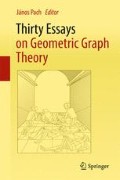Abstract
In the mathematical literature, the term “geometric graph theory” is often used in a somewhat vague sense: to cover any area of graph theory in which geometric methods seem to be relevant to the study of graphs defined by geometric means. In the present volume, by a geometric graph we mean a graph drawn in the plane so that its vertices are represented by distinct points and its edges by (possibly crossing) straight-line segments between these points such that no edge passes through a vertex different from its endpoints. Topological graphs are defined analogously, except that their edges can be represented by simple Jordan arcs [17].
Access this chapter
Tax calculation will be finalised at checkout
Purchases are for personal use only
References
E. Ackerman, On the maximum number of edges in topological graphs with no four pairwise crossing edges. Discr. Comput. Geom. 41, 365–375 (2009)
P. Agarwal, B. Aronov, J. Pach, R. Pollack, M. Sharir, Quasi-planar graphs have a linear number of edges. Combinatorica 17, 1–9 (1997)
M. Ajtai, V. Chvátal, M. Newborn, E. Szemerédi, Crossing-free subgraphs. Ann. Discr. Math. 12, 9–12 (1982)
N. Alon, P. Erdős, Disjoint edges in geometric graphs. Discr. Comput. Geom. 4, 287–290 (1989)
S. Avital, H. Hanani, Graphs. Gilyonot Lematematika 3, 2–8 (1966) [in Hebrew]
D. Bienstock, N. Dean, Bounds for rectilinear crossing numbers. J. Graph Theor. 17, 333–348 (1993)
Ch. Chojnacki (A. Hanani), Über wesentlich unplättbare Kurven im dreidimensionalen Raume. Fund. Math. 23, 135–142 (1934)
P. Erdős, R.K. Guy, Crossing number problems. Am. Math. Mon. 80, 52–58 (1973)
I. Fáry, On straight line representation of planar graphs. Acta Univ. Szeged. Sect. Sci. Math. 11, 229–233 (1948)
H. de Fraysseix, J. Pach, R. Pollack, How to draw a planar graph on a grid. Combinatorica 10, 41–51 (1990)
R. Fulek, J. Pach, A computational approach to Conway’s thrackle conjecture. Comput. Geom. 44, 345–355 (2011)
R.K. Guy, The decline and fall of Zarankiewicz’s theorem, in Proof Techniques in Graph Theory (Academic Press, New York, 1969), pp. 63–69
H. Hopf, E. Pannwitz, Aufgabe no. 167. Jahresbericht Deutschen Mathematiker-Vereinigung 43, 114 (1934)
Y. Kupitz, Extremal problems in combinatorial geometry, in Aarhus University Lecture Notes Series, vol. 53 (Aarhus University, Aarhus, 1979)
T. Leighton, in Complexity Issues in VLSI, Foundations of Computing Series (MIT, Cambridge, 1983)
S. Malitz, A. Papakostas, On the angular resolution of planar graphs. SIAM J. Discr. Math. 7, 172–183 (1994)
J. Pach, Geometric graph theory, in Handbook of Discrete and Computational Geometry, 2nd edn., ed. by J.E. Goodman, J. O’Rourke (Chapman & Hall/CRC, Boca Raton, FL, 2004), pp. 219–238 (Chap. 10)
J. Pach (ed.), Towards a Theory of Geometric Graphs, Contemporary Mathematics, vol. 342 (American Mathematical Society, Providence, RI, 2004)
J. Pach, G. Tóth, Which crossing number is it, anyway? J. Comb. Theor. Ser. B 80, 225–246 (2000)
P. Turán, A note of welcome. J. Graph Theor. 1, 7–9 (1977)
W.T. Tutte, Toward a theory of crossing numbers. J. Comb. Theor. 8, 45–53 (1970)
D.R. Woodall, Thrackles and deadlock, in Combinatorial Mathematics and Its Applications, ed. by D.J.A. Welsh (Academic Press, London, 1969), pp. 335–348
Author information
Authors and Affiliations
Corresponding author
Editor information
Editors and Affiliations
Rights and permissions
Copyright information
© 2013 Springer Science+Business Media New York
About this chapter
Cite this chapter
Pach, J. (2013). Introduction. In: Pach, J. (eds) Thirty Essays on Geometric Graph Theory. Springer, New York, NY. https://doi.org/10.1007/978-1-4614-0110-0_1
Download citation
DOI: https://doi.org/10.1007/978-1-4614-0110-0_1
Published:
Publisher Name: Springer, New York, NY
Print ISBN: 978-1-4614-0109-4
Online ISBN: 978-1-4614-0110-0
eBook Packages: Mathematics and StatisticsMathematics and Statistics (R0)

